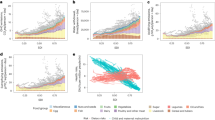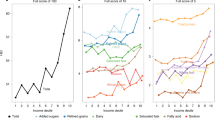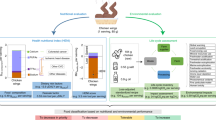Abstract
China’s fast-paced socio-economic transformation has been accompanied by shifting diets towards higher shares of non-starchy foods. Such trends change the dietary health risks but also potentially contribute to growing environmental problems, and thus necessitate an understanding of the links between nutritional quality and environmental impacts of Chinese diets. We assess the nutritional quality of over 21,500 individuals living in nine provinces during the 1997–2011 period and quantify their environmental footprints. Our study shows that the greenhouse gas emissions, water consumption and land appropriation of the average diet increased, driven by consumption of meat, cooking oil and other non-starchy foods. While increasing meat and oil consumption has lead to an increased burden on the environment and a reduction in the nutritional quality of Chinese diets, increases in other non-starchy foods has improved nutritional quality but with increased negative environmental consequences. Our findings identify trade-offs and synergies emerging from analysing the nutrition–environment nexus, and indicate challenges as well as opportunities in reducing environmental impacts while eliminating malnutrition.
This is a preview of subscription content, access via your institution
Access options
Access Nature and 54 other Nature Portfolio journals
Get Nature+, our best-value online-access subscription
$29.99 / 30 days
cancel any time
Subscribe to this journal
Receive 12 digital issues and online access to articles
$119.00 per year
only $9.92 per issue
Buy this article
- Purchase on Springer Link
- Instant access to full article PDF
Prices may be subject to local taxes which are calculated during checkout



Similar content being viewed by others
References
Vermeulen, S. J., Campbell, B. M. & Ingram, J. S. Climate change and food systems. Annu. Rev. Environ. Resour. 37, 195 (2012).
Hoekstra, A. Y. & Mekonnen, M. M. The water footprint of humanity. Proc. Natl Acad. Sci. USA 109, 3232–3237 (2012).
Ranganathan, J. The global food challenge explained in 18 graphics. World Resource Institute Blog http://www.wri.org/blog/global-food-challenge-explained-18-graphics (3 December 2015).
Haddad, L. J. et al. Global Nutrition Report 2015: Actions and Accountability to Advance Nutrition and Sustainable Development (International Food Policy Research Institute, 2015).
The State of Food Insecurity in the World 2015 (Food and Agriculture Organization of the United Nations, 2015).
Ng, M. et al. Global, regional, and national prevalence of overweight and obesity in children and adults during 1980–2013: a systematic analysis for the Global Burden of Disease Study 2013. Lancet 384, 766–781 (2014).
Westcott, P. & Trostle, R. USDA Agricultural Projections to 2023 (United States Department of Agriculture, 2014); https://www.ers.usda.gov/publications/pub-details/?pubid=37751
Li, H., Wu, T., Wang, X. & Qi, Y. The greenhouse gas footprint of China’s food system: an analysis of recent trends and future scenarios. J. Ind. Ecol. 20, 803–817 (2015).
Liu, J. & Savenije, H. H. Food consumption patterns their effect on water requirement in China. Hydrol. Earth Syst. Sci. Discuss. 12, 887–898 (2008).
FAOSTAT (Food and Agriculture Organization of the United Nations, 2015); http://www.fao.org/faostat/en/#data/EL
Prevalence of Undernourishment (% of Population) (World Bank Open Data, 2017); https://data.worldbank.org/indicator/SN.ITK.DEFC.ZS
Bygbjerg, I. Double burden of noncommunicable and infectious diseases in developing countries. Science 337, 1499–1501 (2012).
2015 Report on Chinese Nutrition and Chronic Disease (National Health and Family Planning Commission of the People’s Republic of China, 2015).
Pathak, H., Jain, N., Bhatia, A., Patel, J. & Aggarwal, P. K. Carbon footprints of Indian food items. Agr. Ecosyst. Environ. 139, 66–73 (2010).
de Carvalho, A. M., César, C. L. G., Fisberg, R. M. & Marchioni, D. M. L. Excessive meat consumption in Brazil: diet quality and environmental impacts. Public Health Nutr. 16, 1893–1899 (2013).
World Population Prospects: The 2015 Revision (Department of Economic and Social Affairs of the United Nations, 2015); https://esa.un.org/unpd/wpp/publications/files/key_findings_wpp_2015.pdf
Tilman, D. & Clark, M. Global diets link environmental sustainability and human health. Nature 515, 518–522 (2014).
Springmann, M., Godfray, H. C. J., Rayner, M. & Scarborough, P. Analysis and valuation of the health and climate change cobenefits of dietary change. Proc. Natl Acad. Sci. USA 113, 4146–4151 (2016).
Song, G., Li, M., Semakula, H. M. & Zhang, S. Food consumption and waste and the embedded carbon, water and ecological footprints of households in China. Sci. Total Environ. 529, 191–197 (2015).
Alexander, P., Brown, C., Arneth, A., Finnigan, J. & Rounsevell, M. D. A. Human appropriation of land for food: the role of diet. Glob. Environ. Change 41, 88–98 (2016).
Du, S., Mroz, T. A., Zhai, F. & Popkin, B. M. Rapid income growth adversely affects diet quality in China—particularly for the poor! Social. Sci. Med. 59, 1505–1515 (2004).
Mayén, A.-L., Marques-Vidal, P., Paccaud, F., Bovet, P. & Stringhini, S. Socioeconomic determinants of dietary patterns in low-and middle-income countries: a systematic review. Am. J. Clin. Nutr. 100, 1520–1531 (2014).
Moore, L. V., Roux, A. V. D., Nettleton, J. A. & Jacobs, D. R. Associations of the local food environment with diet quality—a comparison of assessments based on surveys and geographic information systems the multi-ethnic study of atherosclerosis. Am. J. Epidemiol. 167, 917–924 (2008).
Behrens, P. et al. Evaluating the environmental impacts of dietary recommendations. Proc. Natl Acad. Sci. USA 114, 13412–13417 (2017).
Springmann, M. et al. Mitigation potential and global health impacts from emissions pricing of food commodities. Nat. Clim. Change 7, 69–74 (2017).
Zhai, F. et al. The status and trends of dietary nutrients intake of Chinese population. Acta Nutr. Sin. 27, 181–184 (2005).
Ng, S. W., Norton, E. C. & Popkin, B. M. Why have physical activity levels declined among Chinese adults? Findings from the 1991–2006 China Health and Nutrition Surveys. Social. Sci. Med. 68, 1305–1314 (2009).
Popkin, B. M., Adair, L. S. & Ng, S. W. Now and then: the global nutrition transition: the pandemic of obesity in developing countries. Nutr. Rev. 70, 3–21 (2012).
Zhai, F. et al. Dynamics of the Chinese diet and the role of urbanicity, 1991–2011. Obes. Rev. 15, 16–26 (2014).
Vieux, F., Darmon, N., Touazi, D. & Soler, L. G. Greenhouse gas emissions of self-selected individual diets in France: changing the diet structure or consuming less? Ecol. Econ. 75, 91–101 (2012).
Scarborough, P. et al. Dietary greenhouse gas emissions of meat-eaters, fish-eaters, vegetarians and vegans in the UK. Climatic Change 125, 179–192 (2014).
Feng, W., Cai, B. & Zhang, B. A bite of China: food consumption and carbon emission from 1992 to 2007. China Econ. Rev. https://doi.org/10.1016/j.chieco.2016.06.007 (in the press).
Xu, X., Hall, J., Byles, J. & Shi, Z. Assessing dietary quality of older Chinese people using the Chinese Diet Balance Index (DBI). PLoS ONE 10, e0121618 (2015).
Pahlow, M., van Oel, P. R., Mekonnen, M. M. & Hoekstra, A. Y. Increasing pressure on freshwater resources due to terrestrial feed ingredients for aquaculture production. Sci. Total Environ. 536, 847–857 (2015).
Zhuo, L., Mekonnen, M. & Hoekstra, A. Sensitivity and uncertainty in crop water footprint accounting: a case study for the Yellow River basin. Hydrol. Earth Syst. Sci. 18, 2219–2234 (2014).
Acknowledgements
K.F. acknowleges the National Natural Science Foundation of China—NSFC 71628301.
Author information
Authors and Affiliations
Contributions
P.H., G.B., K.H. and K.F. designed the research, P.H. performed the analysis and P.H., G.B., K.H., K.F. and Y.Y. wrote the paper.
Corresponding author
Ethics declarations
Competing interests
The authors declare no competing interests.
Additional information
Publisher’s note: Springer Nature remains neutral with regard to jurisdictional claims in published maps and institutional affiliations.
Supplementary information
Supplementary Information
Supplementary Methods, Results, Tables, Figures and References
Rights and permissions
About this article
Cite this article
He, P., Baiocchi, G., Hubacek, K. et al. The environmental impacts of rapidly changing diets and their nutritional quality in China. Nat Sustain 1, 122–127 (2018). https://doi.org/10.1038/s41893-018-0035-y
Received:
Accepted:
Published:
Issue Date:
DOI: https://doi.org/10.1038/s41893-018-0035-y
This article is cited by
-
Health–environment efficiency of diets shows nonlinear trends over 1990–2011
Nature Food (2024)
-
Health burden from food systems is highly unequal across income groups
Nature Food (2024)
-
Research progress in assessment and strategies for sustainable food system within planetary boundaries
Science China Earth Sciences (2024)
-
The carbon emissions calculation, decomposition and peak scenario simulation of meat, egg, and milk in China: from a production and consumption perspective
Clean Technologies and Environmental Policy (2024)
-
Leverage points for tackling unsustainable global value chains: market-based measures versus transformative alternatives
Sustainability Science (2024)



